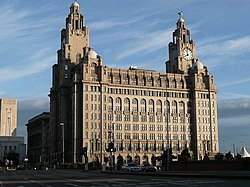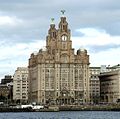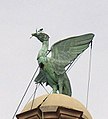Royal Liver Building
| Royal Liver Building | |
|
Lancashire | |
|---|---|
 Royal Liver Building, Pier Head, Liverpool | |
| Type: | Office building |
| Location | |
| Grid reference: | SJ338903 |
| Location: | 53°24’21"N, 2°59’45"W |
| City: | Liverpool |
| History | |
| Built 1908 to 1911 | |
| By: | Walter Aubrey Thomas |
| Office building | |
| Neo-classical | |
| Information | |
| Owned by: | Corestate Capital, Farhad Moshiri |
The Royal Liver Building is a Grade I listed building on the river front in Liverpool, Lancashire. It stands at the Pier Head and along with the neighbouring Cunard Building and Port of Liverpool Building is one of Liverpool's Three Graces, which line the city's waterfront. It is also part of Liverpool's UNESCO-designated World Heritage site known as ‘Liverpool Maritime Mercantile City’.
Opened in 1911, the building is the purpose-built home of the Royal Liver Assurance group, which had been set up in the city in 1850 to provide locals with assistance when losing a wage-earning relative. One of the first buildings in the world to be built using reinforced concrete, the Royal Liver Building stands at 320 feet tall to the top of the spires, and 165 feet to the main roof, with thirteen storeys. The building is now the joint-fourth tallest structure in the City of Liverpool, having been overtaken in height by West Tower, Radio City Tower and Liverpool Cathedral.
Today the Royal Liver Building is one of the most recognisable landmarks in the city of Liverpool. Perched on its towers are two fabled Liver Birds, symbols of the city said to watch over the city and the sea.
History
In 1907 the Royal Liver Group had over 6,000 employees and given the need for larger premises the company gave the go-ahead for the construction of a new head office. Designed by Walter Aubrey Thomas, the foundation stone for the building was laid on 11 May 1908 and just 3 years later, on 19 July 1911, the building was officially opened by Lord Sheffield.[1] The building became the first major structure in Britain, and one of the first buildings in the world, to be constructed using reinforced concrete,[2] and given the building's radical design was considered by some to be impossible to build.[1]
Since its completion in 1911, the building has overlooked the River Mersey from its waterfront location on the Pier Head and forms one of the 'Three Graces' along with the neighbouring Port of Liverpool Building and the Cunard Building. This is reflected in the building's Grade I listed building status.
The building is crowned by a pair of clock towers: as a ship passed along the river, mariners could tell the time from these. The clocks were made by Gent and Co. of Leicester.[3] The clock faces are 24.9 ft (7.6 m) in diameter, larger than those of London's famous landmark, the Great Westminster Clock, holding the distinction of being the largest electronically driven clocks in the UK.[4] They were originally named George clocks, because they were started at the precise time that King George V was crowned on 22 June 1911.[5]
In 1953 electronic chimes were installed to serve as a memorial to the members of the Royal Liver Friendly Society who died during the two World Wars. During hours of darkness, the clock dials are illuminated.
During the early 1950s the sixth floor was occupied and used by No 3 Movements Unit (Embarkation) of the Royal Air Force, overseeing and controlling the movement of RAF personnel and goods through the port.
The building remains the head office for the Royal Liver Assurance, though there are many other tenants in the building.
There is no definitive exterior styling but eclectic references to the Baroque and Byzantine.
In October 2016, the building was put up for sale for the first time in its history.[6] The owner instructed CBRE Group to list the sale with a guide price of more than £40m.[7] A Luxemborg-based investment group, Corestate Capital, bought the building for £48 million pounds in February 2017 along with Everton F.C. majority shareholder Farhad Moshiri. Moshiri plans to run Everton's affairs from the building and have his own office to include a view of the new stadium on Bramley Moore Dock.[8]
The Liver Birds
Atop each tower stand the mythical Liver Birds, designed by Carl Bernard Bartels, looking to the sea and inland, respectively.[9]
Popular legend has it that while one giant bird looks out over the city to protect its people, the other bird looks out to sea at the new sailors coming in to port. Alternatively, local legend states one Liver Bird is male, looking inland to see if the pubs are open, whilst the other is female, looking out to sea to see if there are any handsome sailors coming up the river. Yet another local legend, reflecting Liverpudlians' cynicism, avers that every time a virgin walks across the Pier Head, the Liver Birds flap their wings. It is also asserted by some that if one of the birds were to fly away the city of Liverpool would cease to exist, thus adding to the mystery of the birds. As a result, both birds are chained to the domes upon which they stand; although this could simply be to stop them being carried off in a storm, or by anyone intent of stealing the gilding.
The Liver Birds are of a moulded and hammered copper construction (that is itself fixed onto a rolled-steel armature). They stand eighteen feet high, ten feet long and themselves carry in their beaks an intricately cast sprig of seaweed. Additionally, however, their heads are three-and-a-half feet long, their wing spread is twelve feet and their legs measure two feet in circumference. The two birds - officially cormorants - have identical and almost traditional poses, standing upright with half-raised wings.
Pictures
Outside links
| ("Wikimedia Commons" has material about Royal Liver Building) |
- BBC Liverpool: Royal Liver Building webcam
- National Heritage List 1356370: Grade I
References
- ↑ 1.0 1.1 "Rapid Growth 1886-1913". Royal Liver Group. http://history.royalliverassurance.com/. Retrieved 29 September 2008.
- ↑ Hughes, Quentin (1999). Liverpool: City of Architecture. The Bluecoat Press.
- ↑ "The story of the Royal Liver Building and the people who shaped the organisation behind it.". Friends of Royal Lyver. p. 9. http://www.friendsofroyallyver.co.uk/download/Centenarybooklet-lores.pdf. Retrieved 22 November 2015.
- ↑ "Port Cities: The Royal Liver Building". E. Chambré Hardman Archive. http://www.mersey-gateway.org/server.php?show=ConWebDoc.1322. Retrieved 1 February 2008.
- ↑ "Coast Walk: Stage 4". BBC Liverpool. 21 July 2005. http://www.bbc.co.uk/liverpool/content/articles/2005/07/20/coast05walks_stage4.shtml. Retrieved 1 February 2008.
- ↑ "Liverpool's Royal Liver building is put up for sale". BBC News. 17 October 2016. http://www.bbc.co.uk/news/uk-england-merseyside-37676419. Retrieved 18 October 2016.
- ↑ Dunn, Connor (17 October 2016). "The Royal Liver Building to be put on sale for the first time in its history". Liverpool Echo. http://www.liverpoolecho.co.uk/news/liverpool-news/royal-liver-building-put-sale-12034145. Retrieved 18 October 2016.
- ↑ Houghton, Alistair (8 February 2017). "The Royal Liver Building sold for £48 million". Liverpool Echo. http://www.liverpoolecho.co.uk/news/liverpool-news/royal-liver-building-sold-48m-12571882. Retrieved 8 February 2017.
- ↑ Coen, Susie (25 September 2016). "Seven things you didn't know about our Liver Birds". Liverpool Echo. http://www.liverpoolecho.co.uk/news/liverpool-news/seven-things-you-didnt-know-11934055. Retrieved 18 October 2016.
- Royal Liver Building on Skyscraper Center
- Royal Liver Building on Skyscraperpage
- Royal Liver Building at Structurae





